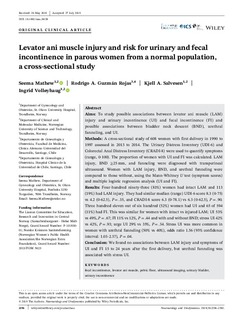| dc.contributor.author | Mathew, Seema | |
| dc.contributor.author | Guzmán Rojas, Rodrigo A. | |
| dc.contributor.author | Salvesen, Kjell Å | |
| dc.contributor.author | Volløyhaug, Ingrid | |
| dc.date.accessioned | 2020-02-04T12:14:12Z | |
| dc.date.available | 2020-02-04T12:14:12Z | |
| dc.date.created | 2020-01-13T11:50:09Z | |
| dc.date.issued | 2019 | |
| dc.identifier.citation | Neurourology and Urodynamics. 2019, 38 (8), 2296-2302. | nb_NO |
| dc.identifier.issn | 0733-2467 | |
| dc.identifier.uri | http://hdl.handle.net/11250/2639551 | |
| dc.description.abstract | Aims
To study possible associations between levator ani muscle (LAM) injury and urinary incontinence (UI) and fecal incontinence (FI) and possible associations between bladder neck descent (BND), urethral funneling, and UI.
Methods
A cross‐sectional study of 608 women with first delivery in 1990 to 1997 assessed in 2013 to 2014. The Urinary Distress Inventory (UDI‐6) and Colorectal Anal Distress Inventory (CRADI‐8) were used to quantify symptoms (range, 0‐100). The proportion of women with UI and FI was calculated. LAM injury, BND ≥25 mm, and funneling were diagnosed with transperineal ultrasound. Women with LAM injury, BND, and urethral funneling were compared to those without, using the Mann‐Whitney U test (symptom scores) and multiple logistic regression analysis (UI and FI).
Results
Four‐hundred ninety‐three (81%) women had intact LAM and 113 (19%) had LAM injury. They had similar median (range) UDI‐6 score 8.3 (0‐75) vs 4.2 (0‐62.5), P = .35, and CRADI‐8 score 6.3 (0‐78.1) vs 6.3 (0‐62.5), P = .90. Three hundred eleven out of six hundred (52%) women had UI and 65 of 594 (11%) had FI. This was similar for women with intact vs injured LAM; UI 53% vs 49%, P = .67; FI 11% vs 12%, P = .44 and with and without BND; stress UI 42% vs 42%, P = .93; urge UI 29% vs 35%, P = .34. Stress UI was more common in women with urethral funneling (50% vs 40%), odds ratio 1.56 (95% confidence interval: 1.03‐2.37), P = .04.
Conclusion
We found no associations between LAM injury and symptoms of UI and FI 15 to 24 years after the first delivery, but urethral funneling was associated with stress UI. | nb_NO |
| dc.language.iso | eng | nb_NO |
| dc.publisher | John Wiley & Sons | nb_NO |
| dc.rights | Attribution-NonCommercial-NoDerivatives 4.0 Internasjonal | * |
| dc.rights.uri | http://creativecommons.org/licenses/by-nc-nd/4.0/deed.no | * |
| dc.title | Levator ani muscle injury and risk for urinary and fecal incontinence in parous women from a normal population, a cross-sectional study | nb_NO |
| dc.type | Journal article | nb_NO |
| dc.type | Peer reviewed | nb_NO |
| dc.description.version | publishedVersion | nb_NO |
| dc.source.pagenumber | 2296-2302 | nb_NO |
| dc.source.volume | 38 | nb_NO |
| dc.source.journal | Neurourology and Urodynamics | nb_NO |
| dc.source.issue | 8 | nb_NO |
| dc.identifier.doi | 10.1002/nau.24138 | |
| dc.identifier.cristin | 1771282 | |
| dc.description.localcode | © 2019 The Authors. Neurourology and Urodynamics published by Wiley Periodicals, Inc. This is an open access article under the terms of the Creative Commons Attribution‐NonCommercial‐NoDerivs License, which permits use and distribution in any medium, provided the original work is properly cited, the use is non‐commercial and no modifications or adaptations are made. | nb_NO |
| cristin.unitcode | 194,65,15,0 | |
| cristin.unitcode | 1920,13,0,0 | |
| cristin.unitname | Institutt for klinisk og molekylær medisin | |
| cristin.unitname | Kvinneklinikken | |
| cristin.ispublished | true | |
| cristin.fulltext | postprint | |
| cristin.qualitycode | 1 | |

